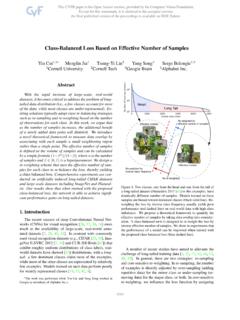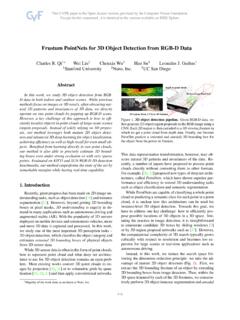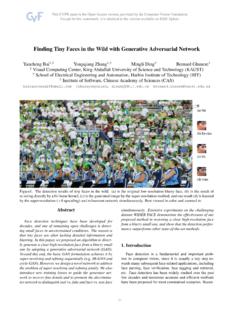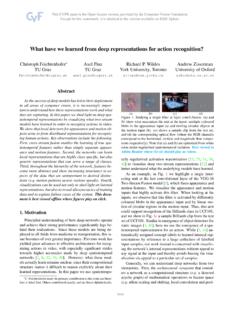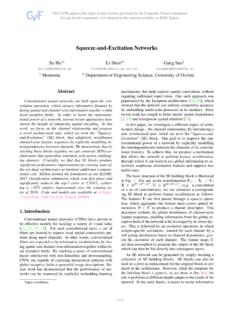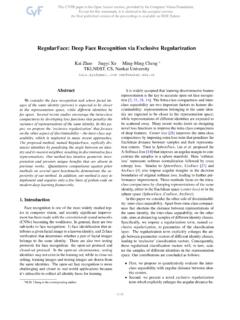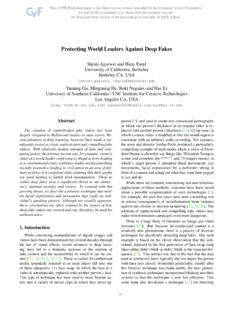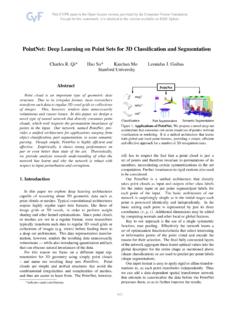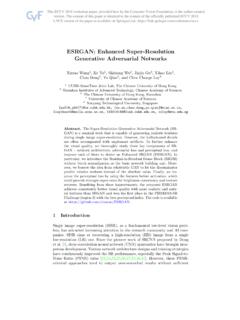Transcription of HigherHRNet: Scale-Aware Representation Learning for ...
1 higherhrnet : Scale-Aware Representation Learning for Bottom-Up Human Pose Estimation Bowen Cheng1 , Bin Xiao2 , Jingdong Wang2 , Honghui Shi1,3 , Thomas S. Huang1 , Lei Zhang2. 1. UIUC, 2 Microsoft, 3 University of Oregon Abstract CNN. Heatmap CNN Aggregation Bottom-up human pose estimation methods have diffi- CNN. culties in predicting the correct pose for small persons due to challenges in scale variation. In this paper, we present higherhrnet : a novel bottom-up human pose (a) Image pyramid. estimation method for Learning Scale-Aware representa- tions using high -resolution feature pyramids. Equipped CNN. with multi-resolution supervision for training and multi- resolution aggregation for inference, the proposed ap- (b) Upsampling input. proach is able to solve the scale variation challenge Heatmap HRNet Aggregation in bottom-up multi-person pose estimation and local- ize keypoints more precisely, especially for small person.
2 The feature pyramid in higherhrnet consists of feature map outputs from HRNet and upsampled higher-resolution (c) Our approach. outputs through a transposed convolution. HigherHR- Figure 1. (a) Using image pyramid for heatmap prediction [33, Net outperforms the previous best bottom-up method by 30]. (a) Generating higher resolution and spatially more accurate AP for medium person on COCO test-dev, show- heatmaps by upsampling image. Recent work PersonLab [33] re- ing its effectiveness in handling scale variation. Further- lies on enlarging input image size to generate high quality feature more, higherhrnet achieves new state-of-the-art result on maps. (c) Our higherhrnet uses high resolution feature pyramid. COCO test-dev ( AP) without using refinement or other post-processing techniques, surpassing all existing pler task of single person pose estimation.
3 As top-down bottom-up methods. higherhrnet even surpasses all top- methods can normalize all the persons to approximately the down methods on CrowdPose test ( AP), suggest- same scale by cropping and resizing the detected person ing its robustness in crowded scene. The code and mod- bounding boxes, they are generally less sensitive to the scale els are available at variance of persons. Thus, state-of-the-art performances on Higher-HRNet-Human-Pose-Estimation. various multi-person human pose estimation benchmarks are mostly achieved by top-down methods. However, as such methods rely on a separate person detector and need to 1. Introduction estimate pose for every person individually, they are nor- mally computationally intensive and not truly end-to-end 2D human pose estimation aims at localizing human systems.
4 By contrast, bottom-up methods [3, 30, 33, 22]. anatomical keypoints ( , elbow, wrist, etc.) or parts. As start by localizing identity-free keypoints for all the persons a fundamental technique to human behavior understanding, in an input image through predicting heatmaps of differ- it has received increasing attention in recent years. ent anatomical keypoints, followed by grouping them into Current human pose estimation methods can be catego- person instances. This strategy effectively makes bottom- rized into top-down methods and bottom-up methods. Top- up methods faster and more capable of achieving real-time down methods [34, 9, 16, 42, 38, 40, 39, 16] take a depen- pose estimation. However, because bottom-up methods dency on person detector to detect person instances each need to deal with scale variation, there still exists a large with a bounding box and then reduce the problem to a sim- gap between the performances of bottom-up and top-down 5386.
5 Methods, especially for small scale persons. ing the performance of large persons (+ AP). This ob- There are mainly two challenges in predicting keypoints servation verifies higherhrnet is indeed solving the scale of small persons. One is dealing with scale variation, to variation challenge. We also provide a solid baseline for improve the performance of small person without sacrific- bottom-up methods on the new CrowdPose [24] dataset. ing the performance of large persons. The other is generat- Our higherhrnet achieves AP of on CrowdPose ing a high -resolution heatmap with high quality for precise test, surpassing all existing methods. This result suggests localizing keypoints of small persons. Previous bottom-up bottom-up methods naturally have the advantages in the methods [3, 30, 33, 22] mainly focus on grouping keypoints crowded scene.
6 And simply use a single resolution of feature map that is 1/4 To summarize our contributions: of the input image resolution to predict the heatmap of key- points. These methods neglect the challenge of scale varia- We attempt to address the scale variation challenge, tion and rely on image pyramid during inference (Figure 1 which is rarely studied before in bottom-up multi- (a)). Feature pyramids are basic components for handling person pose estimation. scale variation, however, smaller resolution feature maps We propose a higherhrnet that generates high - in a top-down feature pyramid usually suffer from the sec- resolution feature pyramid with multi-resolution su- ond challenge. PersonLab [33] generates high -resolution pervision in the training stage and multi-resolution heatmaps by increasing the input resolution (Figure 1 (b)).
7 Heatmap aggregation in the inference stage to predict Although the performance of small persons increases con- Scale-Aware high -resolution heatmaps that are benefi- sistently as input resolution, the performance of large per- cial for small persons. sons begin decreasing when input resolution is too large. We demonstrate the effectiveness of our higherhrnet To solve these challenges, it is crucial to generate spa- on the challenging COCO dataset. Our model outper- tially more accurate and Scale-Aware heatmaps for bottom- forms all other bottom-up methods. We especially ob- up keypoint prediction in a natural and simple way without serve a large gain for medium persons. sacrificing computational cost. We achieve a new state-of-the-art result on the Crowd- In this paper, we propose a Scale-Aware high - Pose dataset, suggesting bottom-up methods are more Resolution Network ( higherhrnet ) to address these chal- robust to the crowded scene over top-down methods.
8 Lenges. higherhrnet generates high -resolution heatmaps by a new high -resolution feature pyramid module. Unlike the traditional feature pyramid that starts from 1/32 reso- 2. Related works lution and uses bilinear upsampling with lateral connection Top-down methods. Top-down methods [42, 38, 40, 34, to gradually increases feature map resolution to 1/4, high - 16, 18, 15, 9, 31] detect the keypoints of a single person resolution feature pyramid directly starts from 1/4 resolu- within a person bounding box. The person bounding boxes tion which is the highest resolution feature in the backbone are usually generated by an object detector [36, 26, 14, 13]. and generates even higher-resolution feature maps with de- Mask R-CNN [16] directly adds a keypoint detection branch convolution (Figure 1 (c)). We build the high -resolution fea- on Faster R-CNN [36] and reuses features after ROIP ooling.
9 Ture pyramid on the 1/4 resolution path of HRNet [38, 40], G-RMI [34] and the following methods further break top- to make it efficient. To make higherhrnet capable of han- down methods into two steps and use separate models for dling scale variation, we further propose a Multi-Resolution person detection and pose estimation. Supervision strategy to assign training target of different resolutions to the corresponding feature pyramid level. Fi- Bottom-up methods. Bottom-up methods [35, 19, 20, 3, nally, we introduce a simple Multi-Resolution Heatmap Ag- 30] detect identity-free body joints for all the persons in an gregation strategy during inference to generate Scale-Aware image and then group them into individuals. OpenPose [3]. high -resolution heatmaps. uses a two-branch multi-stage netork with one branch for We validate our method on the challenging COCO key- heatmap prediction and one branch for grouping.
10 Open- point detection dataset [27] and demonstrate superior key- Pose uses a grouping method named part affinity field which point detection performance. Specifically, higherhrnet learns a 2D vector field linking two keypoints. Grouping is achieves AP of on COCO2017 test-dev without done by calculating line integral between two keypoints and any post processing, outperforming all existing bottom-up group the pair with the largest integral. Newell et al. [30]. methods by a large margin. Furthermore, we observe that use stacked hourglass network [31] for both heatmap pre- most of the gain comes from medium person (there is no diction and grouping. Grouping is done by a method named small person annotation for the keypoint detection task), associate embedding, which assigns each keypoint with a higherhrnet outperforms the previous best bottom-up tag (a vector Representation ) and groups keypoints based method by AP for medium persons without sacrafic- on the l2 distance between tag vectors.
